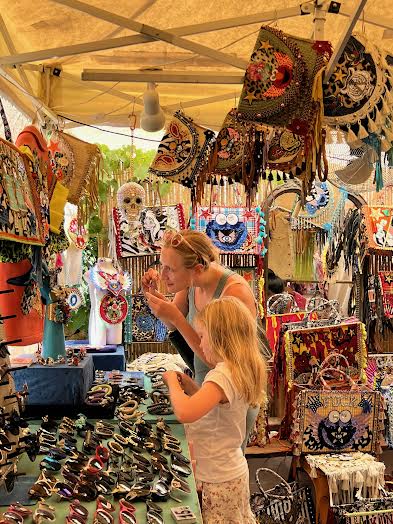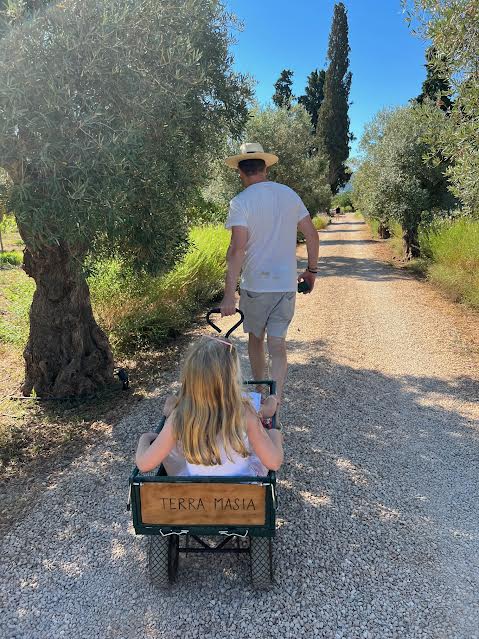I’m standing at the top of Dalt Vila, the fortified medieval town on Ibiza, one of the stunning Balearic islands which lie off the eastern coast of Spain.
All around me is the blue blue blue of the Mediterranean. Today it’s such a deep blue, perhaps because the intense summer sun is so high in the sky.
I take a deep breath, stretch out my arms and inhale the warm salty air. I’m in heaven.
It’s over six years since I visited Europe and I’d forgotten how much I love this sea.
In the distance I can just make out the slender isthmus of Formentera island, renowned for its long bleached sandy beaches and turquoise waters and reachable only by boat.
Behind me rise the sturdy Renaissance stone walls of the Cathedral which was originally built on a site used for temples and other religious buildings during the time of the Phoenicians who arrived on the island in 654BC.
I’m enchanted by the cobbled plazas, steep labyrinthine streets, white cubic houses and stone archways which lead up to the Cathedral and spend half the afternoon wandering around getting lost. I peek my head in through a few doorways hoping to see one of the artists or hippies whom I’m told live here.
During the 1950s and 1960s as tourism began to blossom, Ibiza became known as the hippest/hippiest place in Europe. As Maya Boyd points out in Ibiza Bohemia, despite Franco’s dictatorship of Spain during those years, Ibiza’s outlying position made it a haven of permissiveness fuelled by avant-garde painters, musicians, beatniks and writers.
Still today Ibiza’s hedonistic clubs are reputed to be the best in the world.While standing in line at Barcelona airport for the Vueling flight to Ibiza, I overheard a group of gay guys raving about the parties and clubs they plan to go to.
But I’m here to visit my son Linden and two young granddaughters and that world is not on our radar. They’ve already spent two weeks on the island and come to meet me at the airport with hand-written Welcome placards, a tearful reunion for me after 2 1/2 years of separation during the pandemic.
My son bundles us into the car and we set off for the Airbnb he’s rented, typical of many upmarket houses on Ibiza, a half hour drive north-east of the airport. Its startling white box-like structure echoes the shapes of the small white cubes in Dalt Vila.
The days are long and hot, the sky a bright cobalt blue (let’s add a dash of cerulean to that).
We mostly spend our days swimming. If we’re not swimming in the pool, we’re swimming at one of the many beaches scattered around the rocky coastlines.
The striated colours and hues of the coastal landscape captivate me as do the rocky islets and mysterious coves I glimpse on my early morning walks.
I regret not bringing my watercolour paints and sketch pad with me.
One of the most arresting landscapes is at Es Vedra, a limestone outcrop on the south-west of the island which seems to emerge straight out of the water. Legend has it that it’s one of the most magnetic places in the world and was home to the sirens and sea nymphs who tried to lure Odysseus from his ship in Homer’s Odyssey. In spite of its mythic reputation, there are no metal (magnetic) accumulations there.
But what was magnetic was the glorious sunset we witnessed at the top of the hill after leaving the beach, well and truly worth the traffic jam of impatient drivers all the way up the hill.
What colours, I wondered, would I use to paint that glowing sun as it slid down over the sea? Cadmium red?

It’s along this southern stretch of stunning beaches and extraordinary sunsets that many of the hedonistic beach clubs such as Ushuaia can be found.
Not that they attracted me as I found the wonders of the natural world and Ibiza’s landscape far more alluring.
Most days we have an early dinner/late lunch at one of the beach restaurants dotted around the coast and plunge in to the translucent water afterwards.
We visited Es Torrent, a picturesque seafood restaurant set in a small cove surrounded by rocky cliffs, a couple of times.
I especially enjoyed the freshly shucked oysters, the seafood paella and john dory, dishes which were presented simply and tasted of the sea.
We were too early in the season to try the ‘raons’ (xyrichthysnovacula), the pearly salmon coloured razor fish much sought after for its delectable flavour and gelatinous skin.
My granddaughters loved climbing the twisted juniper trees at Es Torrent though were not so keen on the pebbly beach which made getting into the water challenging. I didn’t have the right soft rubber shoes but my son pressed on, determined to plunge in to the crystal clear water. I stood and watched as my eyes feasted on the light-filled water.
We also visited Sa Caleta, another popular beach restaurant nestled between ochre cliffs.
It was tricky to locate and we wandered along a few sandy tracks before finding it. Originally home to the Phoenicians who were the first settlers, the area has been designated a UNESCO World Heritage site.
I loved the rugged red cliffs which surround the restaurant, the rustic fishermen’s huts which hug the shore and the seafood paella.
We pack a lot in during the week I’m here. One day my son suggests we visit Las Dalias hippy market at San Carlos in the north east of the island. It’s one of a handful of such markets on the island rooted in the hippy movement that spread to Ibiza during the 60s.
Despite the heat, the market is crowded. I’m entranced by the variety and colour of the clothes, jewellery, candles and smell of incense as we wander around.
Another day we drive to Terra Masia, a flourishing organic farm sewn into the hills near Santa Eularia for a late breakfast. My granddaughters clamber into a small wooden cart and we pull them to the outdoor cafe where we order scrambled eggs with avocado and toast and a delicious cooling gazpacho.
Just 6-7 years ago, this 56 hectare farm was an abandoned wasteland. Thanks to environmental scientist Marina Morán Jou and her team of workers, it now produces bountiful seasonal vegetables, flowersand herbs. We bought a large bag of ripe red plum tomatoes, some cucamelons and two fragrant melons.
I learn later that the farm was purchased early this year by Star Dj Calvin Harris who actually gets his hands dirty helping around the farm when not performing at Ushuaia, the big party hotel.
My six year old granddaughter is keen on horse riding and her dad shouted her a week of classes with a skilled young English woman at one of the horse riding schools on the island, another aspect of Ibiza which surprised me.
Towards the end of my week on Ibiza, I discover the reason for the deep blue colour of the sea. Apparently it’s because the Mediterranean is oligotrophic which means it doesn’t contain enough nutrients to support large growths of phytoplankton (algae ). These discolour the water and turn it green or reddish/brown.
If I were to paint it, what colours would I choose? Definitely French Ultramarine, mixed with Prussian blue or Cobalt.Perhaps YinMin Blue, a recently discovered new blue (that’s if I can find it somewhere).
Or perhaps Yves Klein blue which is sometimes described as “ultramarine meets deep blue”?

Yves Klein Blue: “a shade of pure ultramarine Klein claimed to have invented and trademarked. Klein saw monochrome painting as an ‘open window to freedom, as the possibility of being immersed in the immeasurable existence of colour” : MOMA
Klein knew a thing or two about the Mediterranean, having been born in Nice in 1928 on the French Riviera. The story is told that he fell in love with the colour blue one hot day in 1947 while sitting on the beach and was so entranced by it that he went on to create his own distinct blue, IKB (International Klein Blue).
At the the opening of his 1960 exhibition Anthropometries of the Blue Epoch in Paris he directed three naked models to roll around in the blue paint, acting like human paint brushes.
Having walked to the top of Dalt Vila on a hot summer afternoon, I sure feel like rolling around in that deep blue sea below: there’s still a bit of the 1960s hippy in me.
As the Russianpainter William Kandinsky once mused:
“The power of profound meaning is found in blue…Blue is the typical heavenly colour.”
No wonder I felt as if I were close to heaven when I climbed to the top of Dalt Vila.











Divine Sheridan darling! What a wonderful holiday xxx
Thanks Rea – it sure was 🙂